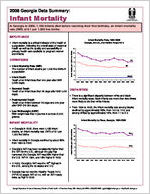2008 Georgia Data Summary:
Infant Mortality
In Georgia in 2006, 1,198 infants died before reaching their first birthday, an infant mortality rate (IMR) of 8.1 per 1,000 live births.
IMPORTANCE
Infant mortality is a critical indicator of the health of a population, reflecting the overall state of maternal health as well as the quality and accessibility of primary health care available to pregnant women and infants.
DEFINITIONS
Infant Mortality Rate (IMR) The number of infant deaths per 1,000 live births in a population.
Infant Death Death of an infant less than one year after birth (<365 days).
Infant Deaths per 1,000 Live Births
Infant Mortality Rate, 1994-2006 Georgia, the U.S., and Healthy People 2010
11
10
9
GA 8
7
US
6
5
HP2010
4 1994 1995 1996 1997 1998 1999 2000 2001 2002 2003 2004 2005 2006
Neonatal Death Death of an infant less than 28 days after birth (<28 days).
Postneonatal Death Death of an infant between 28 days and one year after birth (28-364 days).
Low Birthweight (LBW) Birth weight less than 5 pounds 8 ounces (2,500 grams).
INFANT MORTALITY
In Georgia in 2006, there were 1,198 infant deaths, an infant mortality rate (IMR) of 8.1 per 1,000 live births.
Infant mortality in Georgia declined by about 20% from 1994 to 2006.
Georgia's IMR has been consistently higher than the IMR for the U.S., although the gap has narrowed; the Georgia IMR was 26% higher than the U.S. IMR in 1994, and 16% higher in 2005.
In 2005, Georgia's IMR was the 10th highest in the U.S., among the 50 states and D.C.
DISPARITIES
There is a significant disparity between white and black infant mortality rates; black infants are more than two times more likely to die than white infants.
From 1994 to 2006, the infant mortality rate among blacks declined by approximately 20%, from 16.0 to 12.8, and among whites by approximately 15%, from 7.1 to 6.0.
Infant Deaths per 1,000 Live Births
Infant Mortality by Race, Georgia, 1994-2006
18
16
14
Black
12
10
8 White
6
4
2
0 1994 1995 1996 1997 1998 1999 2000 2001 2002 2003 2004 2005 2006
Georgia has not met the Healthy People 2010 (HP2010) target IMR of 4.5, with an IMR nearly twice as high in 2006.
Georgia Department of Human Resources, Division of Public Health 2 Peachtree Street, NW Atlanta, GA 30303 (404) 657-6436 gdphinfo@dhr.state.ga.us http://health.state.ga.us
INFANT MORTALITY BY HEALTH DISTRICT
The IMR during 2004-2006 was highest in the following Health Districts: 7-0 Columbus (12.1), 5-2 Macon (11.3), and 8-1 Valdosta (11.1).
The IMR was lowest in the following health districts: 2-0 Gainesville (5.3), 1-2 Dalton (6.4), 3-1 Cobb/Douglas (6.6), and 3-4 Lawrenceville (6.6).
IMR by District, Georgia, 2004-2006
LEADING CAUSES OF INFANT MORTALITY
The most common causes of infant mortality are short gestation/LBW (not otherwise classified), congenital malformation/chromosomal abnormality, and SIDS.
Number of Infant Deaths
Leading Causes of Infant Mortality, Georgia, 2004-2006
300
265
(22%)
250
225 (19%)
200
175
(16%)
150
2004 2005 2006
212
189 (16%)
198 (18%)
(18%)
150
130 125 (13%) (11%) (11%)
100
50
0
Short Gestation / LBW (not otherwise classified)
Congenital Malform. / Chromosomal Abnorm.
Sudden Infant Death Syndrome (SIDS)
INFANT MORTALITY BY COUNTY
The IMR was highest in the following counties during the 2004-2006 time period: Telfair (21.7), Treutlen (18.5), Hancock (18.0), Long (16.3), and Marion (16.2).
The IMR was lowest in the following counties: Habersham (3.4), Forsyth (3.8), Cherokee (4.1), Fayette (4.5), and Madison (4.8).
IMR by County, Georgia, 2004-2006
In 2006, the leading causes of neonatal mortality (771 deaths) were short gestation/LBW (202, 26%), congenital malformation/chromosomal abnormality (137, 18%), and respiratory distress of the newborn (71, 9%).
In 2006, the leading causes of postneonatal mortality (427 deaths) were SIDS (136, 32%), congenital malformation/ chromosomal abnormality (75, 18%), and accidents (31, 7%).
OPPORTUNITIES FOR PREVENTION3
Get good preconception and prenatal care to identify and treat problems early.
Eat a healthy diet and gain an appropriate amount of weight during pregnancy, which can help to reduce the risk of having a low birthweight baby.
Take a multivitamin containing 400 micrograms of folic acid, even prior to pregnancy, to help prevent birth defects.
Avoid cigarettes, alcohol, and illicit drugs, which can cause birth defects, slow fetal growth, and lead to premature delivery.
Be aware of and avoid risk factors for SIDS: stomach or side sleeping, soft sleep surfaces, loose bedding, overheating, smoking, and bed sharing.
Data sources: 1. Birth and Death Vital Records Data (1994-2006), OHIP Data Warehouse 2. National Center for Health Statistics, final mortality data, 1990-1994 and period linked birth/infant death data, 1995-present.
Retrieved from www.marchofdimes.com/peristats. 3. The March of Dimes website: www.marchofdimes.com.
Date updated: September 2008 Publication number: DPH08.301HW Visit http://www.health.state.ga.us/programs/family/index.asp for more information about infant health in Georgia.
Georgia Department of Human Resources, Division of Public Health 2 Peachtree Street, NW Atlanta, GA 30303 (404) 657-6436 gdphinfo@dhr.state.ga.us http://health.state.ga.us
